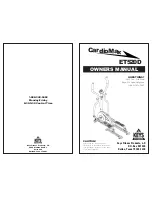
6
15
calorie burning. Interval training means alternating short periods of higher intensity
gliding (the “power glides” demonstrated in your video), with periods of lower
intensity gliding. When you perform the high intensity exercises, you will work at a
level that is at the high end or may exceed your Target Heart Rate Zone. The lower
intensity exercises are at the low end of your Target Heart Rate.
Monitor your estimated heart rate throughout your workout. It can help you
determine the level of exertion that may be most appropriate for you, and serve as a
good measure of your progress toward improved fitness.
Beginners can use interval training to simply alternate periods of moderate gliding
with rest periods of easy gliding. If you are having difficulty completing 20 minutes
of non-stop gliding, work for 3 or 4 minutes then rest with a very small glide for 1
minute. Repeat this until your 15 - 20 minutes are complete.
There are three variables that will help you control the intensity of
your Gazelle Power Plus workout and keep your heart rate at a safe
and appropriate level:
•
The range of motion of your legs and arms.
A wider glide will be higher
intensity than a small or narrow glide. Gliding with your knees in a neutral or
straight position is easier than gliding with your knees bent in a low position.
•
Your hand position.
A high or low hand grip will allow your arms or legs to
alternately work harder. A neutral or middle hand grip will be easier than a
high grip because the legs and arms will share the workload evenly.
•
The speed at which you glide.
As you glide at faster tempos your effort will
increase. Slowing down the tempo at any time will make your workout easier.
Cool Down
Towards the end of your workout, do 5 to 10 minutes of easy exercise to cool down.
You can do this by doing the basic glide movement and gradually slowing down the
range of motion and tempo. Step off your unit and complete your workout with some
gentle stretches as demonstrated in your video. This allows your heart rate to drop
gradually back toward its normal resting rate.
A Total Fitness Program is more than exercise and more than eating right. It is a “fitness
for life” plan that goes hand in hand with an overall healthy lifestyle. This includes
regular check-ups and exercise, now and for the rest of your life.
Your total fitness program consists of three parts:
• Aerobic exercise to burn calories.
• Strength conditioning exercises to tone and shape your muscles,
increase your metabolic rate, and strengthen your bones.
• A diet that is safe, sensible and healthy.
Today, all fitness research recommends both aerobic exercise and strength conditioning
to achieve balanced fitness. By improving your aerobic fitness you will strengthen your
heart and lungs, increase your stamina and endurance, and help with weight loss.
Strength conditioning adds lean muscle to your body, increasing your body’s metabo-
lism. In this process, your body burns more calories, even while you rest. When you
combine aerobic workouts with strength conditioning, as you will with your Gazelle
Power Plus, you can burn more fat and calories than with just aerobic exercise alone.
The Gazelle Power Plus workout will help with the first two parts of your Total Fitness
Program, but you need to make healthy, low-fat eating a big priority as well.
Consult with your physician
about an eating plan that’s right for you. Healthy
eating habits and exercise will help you reach your goal. We recommend that you
follow dietary guidelines approved by the U.S. Department of Agriculture and the
U.S. Department of Health and Human Services. These guidelines are contained in
the Food Guide Pyramid.
Fruit
Group
Vegetable
Group
Bread, Cereal, Rice
& Pasta Group
Fats, Oils,
& Sweets
Meat, Poultry,
Fish, Beans,
Eggs & Nuts
Milk,
Yogurt &
Cheese
KEY
Fat (naturally
occurring and
added)
Sugar
(added)
Starting at the base of the pyramid,
you should strive for 6 - 11 servings a
day from the Bread, Cereal, Rice and
Pasta food group. You should eat 3 - 5
servings a day from the Vegetable
group, and 2 - 4 servings from the
Fruit group. You should also eat 2 - 3
servings a day from the Milk, Yogurt
and Cheese group, and from the Meat,
Poultry,Fish, Beans, Eggs and Nuts
food group. Lastly, use Fats, Oils and
Sweets sparingly.
Also include at least
8 glasses (8 oz. each)
of water every day.
Y
OUR
T
OTAL
F
ITNESS
P
ROGRAM
▼
T
ARGET
H
EART
R
ATE
Z
ONE
▼
BEFORE STARTING THIS OR ANY OTHER EXERCISE PROGRAM, CONSULT YOUR
PHYSICIAN,
who can assist you in determining the target heart rate zone appropriate
for your age and physical condition. Certain exercises, programs or types of equipment
may not be appropriate for all people. This is especially important for persons over the
age of 35, pregnant women, or those with pre-existing health problems or balance
impairments.
MONITOR YOUR HEART RATE WHILE YOU EXERCISE AND KEEP YOUR
ESTIMATED PULSE RATE WITHIN YOUR TARGET HEART RATE ZONE.
Follow the
instructions on page 7 in this manual regarding heart rate monitoring and how to deter-
mine your appropriate target heart rate zone. When used properly, the heart rate pulse
sensors and display monitor provide a reasonably accurate estimate of your actual heart
rate. This estimate is not exact and persons with medical conditions and/or a specific
need for accurate heart rate monitoring should not rely on the estimations provided.



























